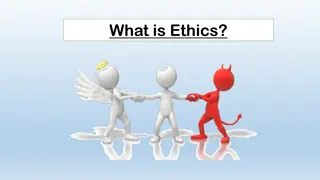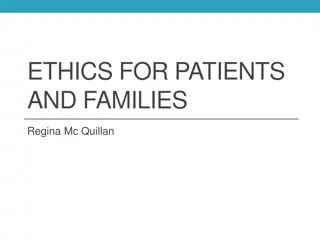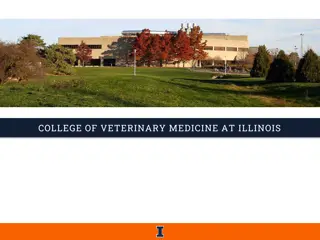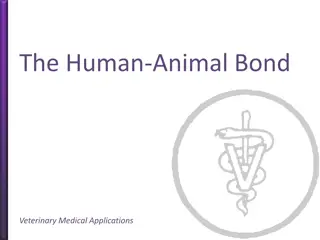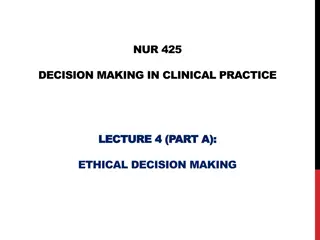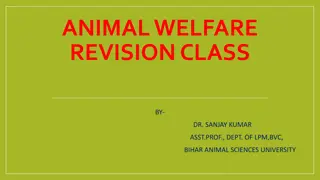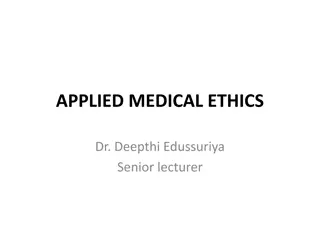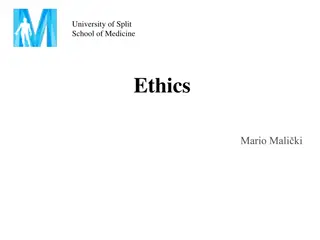Ethics in Veterinary Medicine: Addressing Ethical Dilemmas in Animal Care
Ethics in veterinary medicine focuses on the moral aspects of human behavior and decision-making when faced with conflicting choices. It explores key issues such as animal surgeries, hospitalization, and euthanasia, aiming to determine the most ethical course of action in treating animals. Veterinary professionals must navigate complex ethical dilemmas to uphold the well-being of both animals and their owners.
Download Presentation

Please find below an Image/Link to download the presentation.
The content on the website is provided AS IS for your information and personal use only. It may not be sold, licensed, or shared on other websites without obtaining consent from the author. Download presentation by click this link. If you encounter any issues during the download, it is possible that the publisher has removed the file from their server.
E N D
Presentation Transcript
What is Ethics? Ethics: looks at the moral source of human behavior Why do we act the way we do? attempts to determine the best course of action when conflicting choices How do we decide what to do when people disagree about something? is a key component to living within a society in a civilized way
Ethical Issues Some examples of veterinary ethical issues include: Are surgeries such as ear cropping, declawing or debarking always appropriate? Is it okay for animals to be hospitalized overnight without nurse supervision? Should animals be temporarily put to sleep for radiographs to lessen human exposure?
Euthanasia of Treatable Horse for Insurance You are a team (group of 4) of veterinarians faced with determining the best course of action in the face of a difficult situation. Read the scenario on the handout and discuss the consequences of each possible decision. Come up with what your team believes is the most ethical conclusion and prepare to explain the reasoning behind your choice to the rest of the class.
Reasoning: Where to start? This case raises the fundamental question of veterinary ethics: To whom does the veterinarian have primary commitment to in cases of competing interests: the owner or the animal? Owner s interest: the animal be euthanized so he or she can collect the $30,000. Animal s interest: have the injury repaired since it will be capable of returning to a good quality of life.
Decision: What to do? The veterinarian s options are to: Refuse to perform the euthanasia Noble but the client could just find another vet to euthanize the horse The vet may lose credibility with other clients 1. Approach the insurance company and ask permission to save the horse They have already agreed to pay the client, they do not lose anything by saving the horse 2.
Relationships The Veterinarian -- Patient Relationship The Veterinarian -- Veterinarian Relationship The Veterinarian -- Society Relationship
The Veterinarian -- Patient Relationship From The American Veterinary Medical Association (AVMA) First consider the needs of the patient: to relieve disease, suffering, or disability while minimizing pain or fear. In emergencies: veterinarians have an ethical responsibility to provide services for animals when necessary to save life or relieve suffering.
The Veterinarian -- Veterinarian Relationship From The American Veterinary Medical Association (AVMA) Strive to enhance their image with respect to their colleagues and other health professionals. Be honest, fair, courteous, considerate, and compassionate. Do not slander, or injure the professional standing or reputation of other veterinarians in a false or misleading manner.
The Veterinarian -- Society Relationship From The American Veterinary Medical Association (AVMA) The responsibilities of the veterinary profession extend to society in general. Veterinarians are encouraged to make their knowledge available to their communities and to provide their services for activities that protect public health.
Animal Rights & Animal Welfare What s the Difference?
Animal Rights The idea that animals should have the same moral rights as humans. for example, the rights not to be used for food, clothing, entertainment, medical research, or product testing.
Animal Rights There is a continuum of rights for animals, ranging from few or no rights to lots of rights. Our own individual belief systems all fall somewhere along this continuum. few rights many rights Rights for Animals
Few to No Rights Some, like the 17th century philosopher Descartes, may believe that animals are little more than machines that they have no feelings at all. Such a belief system suggests that animals have few if any rights. few rights Rights for Animals
Same Rights as Humans Some animal rights supporters are at the other extreme believing that all animals should have the same moral rights as humans. This belief system suggests that animals should have the same rights as humans. many rights Rights for Animals
Animal Rights Most zoo & aquarium professionals fall somewhere along the middle of the continuum, believing that animals have the right to humane care. Our individual belief systems based on our individual experience, education, culture, religion, etc. give us our varying opinions on the rights of animals. few rights many rights Rights for Animals
Animal Welfare The Animal Welfare Committee defines it as a combination of an animal s physical health and psychological well-being. Animal welfare people believe that animals can be used for human purposes, but that they should be treated so that discomfort is kept to a minimum.
Animal Welfare Physical Health involves appropriate nutrition exercise social groupings veterinary care environmental conditions
Animal Welfare Psychological Well-Being involves addressing animals motivational needs providing animals with choice and control matching the environment to animals natural adaptations encouraging animals to develop and use their cognitive abilities
Animal Welfare To enhance animal welfare, we need to recognize five important points: 1. Animal welfare ranges on a continuum from very poor to very good. There are no clear dividing lines between good and bad .
Animal Welfare 2. Animal welfare must be assessed at the individual animal level, not at the group or species level.
Animal Welfare 3. Good welfare will look different for different individual animals - it s relative, not absolute.
Animal Welfare 4. There is no single measure of welfare - we need to look at multiple variables to assess welfare.
Animal Welfare 5. Welfare is a quality of the animal - it is not something that we provide to animals (what we provide are appropriate conditions, the potential for animals to experience good welfare).
Animal Welfare Policy The American Veterinary Medical Association (AVMA) asks that your team provide comments on an animal welfare-related policy that is under review. POLICY: The AVMA strongly encourages owners of domestic cats in urban and suburban areas to keep them indoors. ACTION: Comment on the inclusion or exclusion of rural ("farm") cats from AVMA policy on keeping owned cats indoors. Read the handout and answer the questions that follow.
Animal Welfare Policy 1. Do you agree that urban and suburban cats should be housed indoors (for their safety and to protect wildlife)? 2. Is there a reason for suggesting that concerns about cats' safety and wildlife considerations in rural areas differ from those in urban and suburban areas? 3. Are there other good reasons for keeping rural cats outdoors? For keeping urban and suburban cats indoors?
Animals in Research Virtually every medical achievement of the last century has depended directly or indirectly on research in animals. - U.S. Public Health Service
Animals in Research In order for medical researchers to learn how to treat a disease, they have to study it in a living organism. Animals are physiologically similar to humans and are therefore good models when humans cannot be used. Animals have been used to test multiple vaccines for both animal and human benefits. Anthrax: sheep (1880s) Cholera: various animals (1885) Rabies: various animals (1885) Insulin for Diabetes: dogs (1922) Leprosy: armadillos (1950s)
Human Responsibility Ethical treatment of animals means that those animals used in testing should be treated well. Monitored by Institutional Animal Care and Use Committees, ethical treatment of animals includes: Providing a comfortable living environment Minimizing discomfort from testing Humanely euthanizing animals
SOURCES American Veterinary Medical Association (AVMA) An Introduction to Veterinary Medical Ethics: Theory and Cases by Bernard E. Rollin Institutional Animal Care and Use Committees Google Images






